
CMO Corner: Lawrence Magras, MD, MBA, FHM, FAAPL
Care Management – Patient Activation Measure (PAM)
The HUSKY Health Care Management program has incorporated the Patient Activation Measure (PAM); an evidence-based survey to measure a member’s activation by assessing knowledge, skill, and confidence in managing one’s health. . . read more
Patient activation is an important assessment and intervention domain because activated members are more likely to engage in preventive care and self-management behaviors, and to experience better health outcomes, improved care experiences, lower healthcare costs, and stronger patient-provider relationships.1
The PAM is comprised of 10 scored declarative statements where an individual indicates how much they agree or disagree with each statement. The outcome of a completed PAM survey score aligns with one of four levels of patient activation, with PAM Level 1 being the lowest level of activation, and PAM Level 4 being the highest level of activation. Care Management staff use the member’s PAM level to tailor a person-centered team care plan focusing on assisting the member in becoming more activated in their health and healthcare. Numerous studies have demonstrated that increasing activation is key to ensuring positive health outcomes and improved patient self-management.2 Interventions within the team care plan will be unique to the member’s needs and may include: coaching to support further understanding of their health condition; developing an informed therapeutic relationship with their provider(s); action planning; care coordination to address barriers to accessing needed care; approaches to engaging in proactive care versus reactive care; sustaining healthy lifestyle changes; and consistent medication taking. The member’s PAM level and care plan are shared with their providers, with the member’s consent.
1 Urbanski, C. (2025). 10 Strategies to Increase Patient Activation. Retrieved from https://www.phreesia.com/10-strategies-to-increase-patient-activation
2 Heath, S. (2020). Patient Engagement Strategies for Improving Patient Activation. Retrieved from Patient Engagement HIT: https://patientengagementhit.com/features/patient-engagement-strategies-for-improving-patient-activation
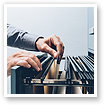
HEDIS® Medical Record Review is Nearing Completion
As the Administrative Services Organization (ASO) for the Connecticut Department of Social Services (DSS), Community Health Network of Connecticut, Inc.® (CHNCT) performs a review on a sample of HUSKY Health members’ medical records as part of the annual HEDIS® quality review. . . read more
HEDIS® is part of a nationally recognized quality improvement initiative developed and managed by the National Committee for Quality Assurance (NCQA). The rates obtained on the Medicaid quality measures are used by DSS to monitor the performance of the ASO and to identify opportunities to improve the HUSKY Health program. Medical record requests were sent out at the beginning of February 2025. If you have not yet submitted the requested records, please do so as soon as possible.
CHNCT has resources to assist your practice with reporting these health measures. Go to www.huskyhealthct.org and click on “Provider Home.” To find resources to help with health measures, click on “Reports & Resources,” then “Health Measures.” This will provide you access to TIP Sheets for many of the HEDIS® and other health measures. You can access even more resources by logging in to the HUSKY Health secure provider web portal, where you will find reports developed specific to your practice and the HUSKY Health members you treat.
Should you have any questions about HEDIS® or how to submit medical records, you can call Quality Management at 1.866.317.3301 or email quality@chnct.org.
The Healthcare Effectiveness Data and Information Set (HEDIS®) is a registered trademark of NCQA.
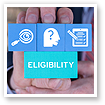
HUSKY Health Member Eligibility Tools
HUSKY Health is committed to easing the administrative burden for Connecticut Medical Assistance Program (CMAP)-enrolled providers and their staff when providing care for HUSKY Health members. Did you know that HUSKY Health has tools available to you and your staff that can be accessed online or via telephone 24 hours a day, 7 days a week?. . . read more
Automated Eligibility Verification System & Automated Voice Response System
The Automated Eligibility Verification System (AEVS) provides a comprehensive source of Department of Social Services (DSS) member eligibility information to all CMAP-enrolled providers to verify member eligibility, such as third-party insurance, Medicare coverage, waiver program eligibility, and Medicare-covered services information. The system also provides self-service features, such as member eligibility verification and downloading of pertinent forms.
To access the AEVS, please visit the DSS CMAP website. Under the provider menu, log in to the CMAP secure site. Providers can also call the CMAP Automated Voice Response System (AVRS) at 1.800.842.8440 and select the self-service menu option. The AVRS is available 24 hours a day, 7 days a week (except for maintenance) to verify member eligibility. A verification number will be provided when verifying member eligibility and should be maintained in your patient records.
Member Identification Cards
HUSKY Health program members are issued a member identification card shortly after their enrollment. The identification card contains the member’s name, member identification number (which is their Medicaid ID number), applicable cost share information (HUSKY B), and the specific HUSKY Health plan name.
Below is a sample of the identification card issued to HUSKY Health program members:
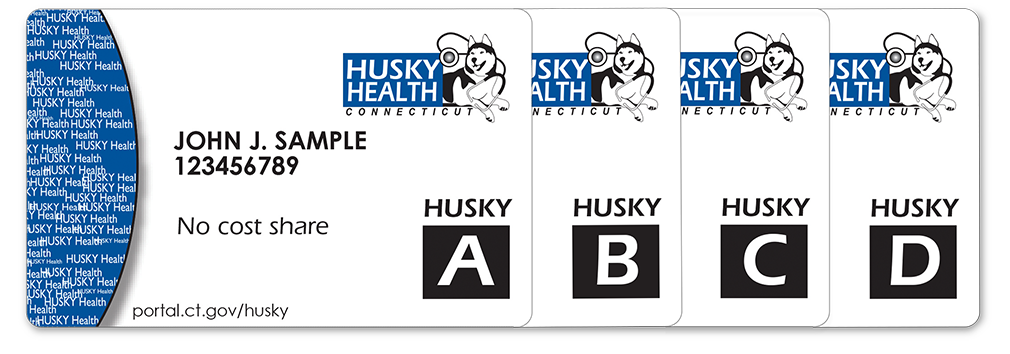
The State of Connecticut also issues every active Medicaid recipient a gray CONNECT CARD with the recipient’s name, Medicaid ID number, and the card issue date. The identification number on the gray CONNECT CARD is the same identification number listed on the HUSKY Health member identification card.
Below is a sample of the gray CONNECT CARD issued to every active Medicaid recipient:
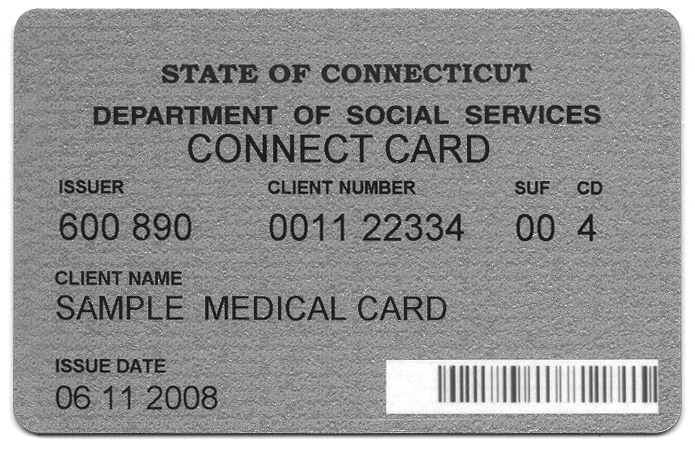
Member eligibility doesn’t appear on the CONNECT CARD, and possession of this card doesn’t guarantee eligibility. Providers may use this card to help determine member eligibility through the AEVS or AVRS.

Health Library Transition to MedlinePlus
As of December 2024, the health information library on the HUSKY Health website has transitioned to MedlinePlus. . . read more
You can still access it from the HUSKY Health Provider website under “Reports & Resources” and “Health Library.”

What is MedlinePlus?
MedlinePlus is an online health information resource for patients and their families and friends. It’s a service of the National Library of Medicine (NLM), the world’s largest medical library, which is part of the National Institutes of Health (NIH). The goal of MedlinePlus is to present high-quality, relevant health and wellness information that is trusted, easy to understand, and free of advertising, in both English and Spanish. MedlinePlus offers information on health topics, human genetics, medical tests, medications, dietary supplements, and healthy recipes.
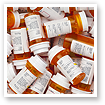
National Drug Take Back Day
Drug overdoses are a major public health concern in the United States. In Connecticut, residents are more likely to die from an unintentional drug overdose than a motor vehicle crash, with the majority of these deaths being attributed to illicit opioids.1 Proper disposal of unwanted or unused medications can help curb drug diversion and ensure that prescription medications don’t get into the wrong hands. . . read more
While there are ways to dispose of medications safely at home, the Drug Enforcement Administration (DEA) sponsors a National Prescription Drug Take Back Day twice per year to provide a safe and responsible way to dispose of unused medications. The 2025 National Prescription Drug Take Back days are scheduled for April 26 and October 25, with collection happening between 10:00 a.m. and 2:00 p.m. at each designated site. In addition to the biannual nationwide event, the DEA website provides a list of authorized collection sites where individuals can drop off their unwanted medications year-round. If a take back event isn’t readily accessible, patients should be encouraged to remove medications from their original containers, mix them with something undesirable such as coffee grounds or cat litter, place them in another container, and throw them in the trash. To search for a list of authorized collection sites in your area visit www.dea.gov/takebackday.
1 Opioid and drug overdose statistics. CT.gov. (n.d.). Retrieved January 2, 2025, from https://portal.ct.gov/DPH/Health-Education-Management--Surveillance/The-Office-of-Injury-Prevention/Opioid-and-Drug-Overdose-Statistics

